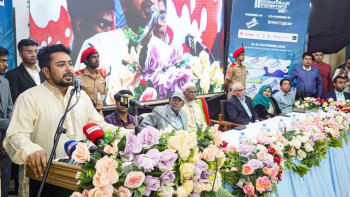When art tackles the inadequacy of language

It was sometime in winter last year that co-curator Sharmilie Rahman invited a group of artists—Abdus Salam, Abir Shome, Emran Sohel, Hadi Uddin, Jewel A Rob, Marzia Farhana, Mizanur Rahman Chowdhury, Mustafa Zaman, Razib Dutta, Sanjid Mahmud, Shehrin Akhter, Syed Muhammad Zakir and Yasmin Jahan Nupur—to a commune in Bormi, Gazipur. For three days, the artists found ways to self-reflect, to connect with the land, the people and the environment in the village of Bormi and discover what creative output they could produce. ‘(Un)seen’, the exhibition on display at Bengal Shilpalay, Dhanmondi from June 22 to August 3, isn’t so much a result of the retreat as it is in parts remembrance, representation and reproduction of the artists’ experiences there.
Emran Sohel’s installation comprises a blank white board—a makeshift wall of sorts. The top half is covered by an image of the trees at Bormi, connected to each other by white zigzags. That the image is a memory of the artist’s stay at Bormi, and not simply a picture of trees, is made clear first by a red tinge filtering the image, and more importantly by the way the image is cut off by a sharp, jagged lower border. The bottom half of the wall remains blank, sparsely accessorised by other objects—what looks like the corner of a wooden drawer or table, a thin shaft of wooden blinds propped against the wall, a red pipe disappearing into the wall.

Yasmin Jahan Nupur’s photography displayed on another wall likewise remembers her performance art at Bormi, comprising shots of her hair caught in the branches of trees there, her hands hugging a trunk, her sweaty ear and neck pressed against its gnarly surface. The pictures form a jagged line on the sparse white surface. Similarly, Mizanur Rahman Chowdhury’s piece consists of a mound of earth trailing across the ground until it is cut off by a propped-up mirror, while Jewel A Rob’s photography focuses on the imprints left by twigs, branches, and gardening tools on soil.

Marzia Farhana’s sculpture ‘The Untold Story of Things’, meanwhile, made of tin sheets, aluminium plates and chunks of texts collected from journals and newspapers, highlights how ‘(Un)seen’ contains memories in material form also, instead of just through physical set up. The pile of sheets contains “traces of time”, explains Marzia. Having once served as the building blocks of locals’ homes in and around Bormi, the materials record the impacts left behind by sunlight, by rainfall and floods, thus telling the story of the insecurities faced by those at the mercy of the environment.

Each of these installations, works on three levels. First, they travel back to the artists’ experiences at Bormi—the time they spent understanding the space and acclimating to it on a creative level. They then transport those experiences to the present, to the ‘white cube’ of the gallery. And finally, they trail off just short of fully recreating the artists’ work at the original site, pushing the audience to decipher the rest. What else did the rest of Emran Sohel’s image of the forest capture? What inspired the multi-colour scrawl of Bengali alphabets in Sanjid Mahmud’s prints? What did it truly feel and look like, as Abdus Salam sat crouching inside a cage in Bormi? We must imagine, must create on our own these parts of the installations left ‘unshown’.
“Our biggest challenge lay in carrying and reframing the installations in the ‘white cube’,” explains Mustafa Zaman, co-curator of the exhibition who first joined the retreat as a participating artist. “The experience of sitting in a field, for instance, evolves from a memory into an art piece once it is transported to the gallery. Each piece required its own personal space in the gallery. Many of them worked with soil, which posed its own challenges. We had to decide which pieces would be recreated in the gallery and which ones would be represented through photography, video clips and other props.”

He explains how the entire point of the initiative was to highlight the inadequacy of language, particularly in describing memory, experience, and emotions, and how visual media can fill those gaps in expression. The exhibition engages with this problem quite creatively, offering as a substitute for one’s presence in a past moment an intriguing mix of shadows, video clips, out-of-date technology and debris and, most interestingly, blank space. The placing of these objects is effective too. Instead of merely looking at them, one has to crouch, squint, bend the head in certain angles to make sense of the visual. These elements all highlight the curators’ fascination with the German semiological concept of ‘umwelt’, the idea that organisms perceive reality in uniquely individual sensory ways. They do so—and this is perhaps the most interesting aspect of the exhibition—not by telling the audience that artists experienced and produced their art in so and so ways, but by engaging the audience in the very process of completing the images on display. A dialogue thus emerges in the upstairs gallery of Bengal Shilpalay with this exhibition, as the artists and the audience collectively decide what is to be ‘seen’.



 For all latest news, follow The Daily Star's Google News channel.
For all latest news, follow The Daily Star's Google News channel. 



Comments